My experience collaborating with the research and conservation of the Galapagos sea turtle.
Author: Diana Loyola
As a Galapagueña, I am thrilled to be part of the Charles Darwin Foundation (CDF) and thus be able to help with the conservation of the Galapagos Islands. The project that studies sea turtles (Chelonia mydas) opened its doors to me two years ago, when I started as a field assistant. This is where I learned all about this wonderful species. During this time, I had the opportunity to share what I have learned with other members of my community, people of different ages and belonging to different sectors. All this, through talks, workshops and experiences, especially sharing with young students, who are very interested in turtle conservation.
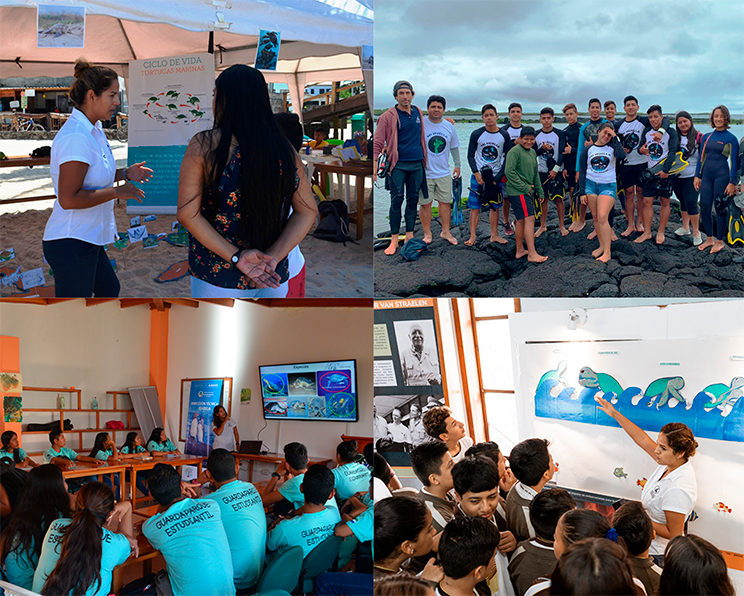
My experience working with sea turtles in the field.
Each year, from January to March, we carry out fieldwork. This takes place in the northern coast of Santa Cruz Island, on a sea turtle nesting beach and very important tourist site called "Las Bachas". During these months, a camp with volunteers and Galapagos National Park (GNP) staff is set up here during the nesting season to monitor the sea turtles' reproductive activity. Each night the GNP group stays up to monitor the turtles nesting activity at the site. As part of the bi-institutional project developed by the CDF and Queen's University Belfast (QUB), our focus for the past three years has been to study the risks of collision between sea turtles and boats. We do so by attaching multichannel electronic devices to sea turtles to record audio and video to document the behavior and movement of the green turtles in their natural habitat.

The reason why we record their behavior is to see when they come up to breathe, mate, and swim just beneath the sea surface because these activities put the green turtles at risk of collision with vessels. This is because many of the sites where sea turtles accumulate in the Galapagos are in areas close to the coast, urban centers, and ports whish have high marine traffic. This leads to interactions between turtles and boats, resulting in collisions which cause injuries to their carapace and even maiming in their limbs or death. Studying their movements and surface behavior allows us to understand the areas where sea turtles are at risk of collision.
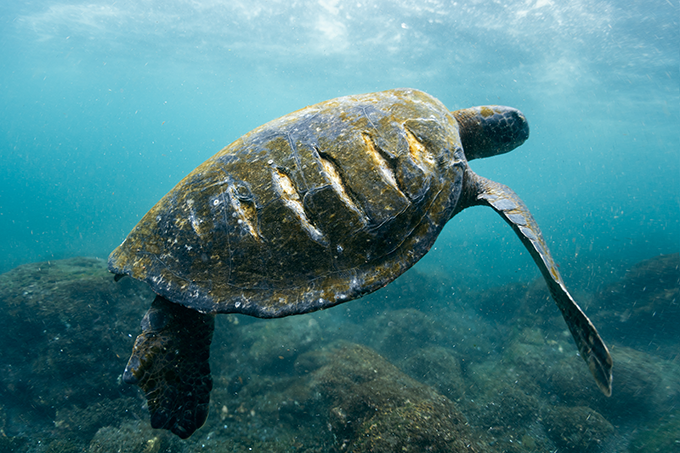
Looking for the ideal turtle!
Back on our expedition, it takes one or two nights to find a nesting female suitable for us to attach a multichannel electronic device. The search takes place only at night, because sea turtles arrive to the beach after sunset to avoid the possible predators that are more active during the day. On night walks on the beach, we check each of the turtles that come out to nest and choose the one that has suitable physical conditions such as size (greater than 85 cm curved carapace length) and no wounds on its carapace to attach the device. But without a doubt, the most important thing to check is that the turtle is starting its nesting cycle of the season, that is, it is the first time that she visits the beach during the first weeks of the nesting season. This is necessary to increase the chance of the turtle returning for subsequent nesting, in the same season. This is so we can retrieve the device later on.
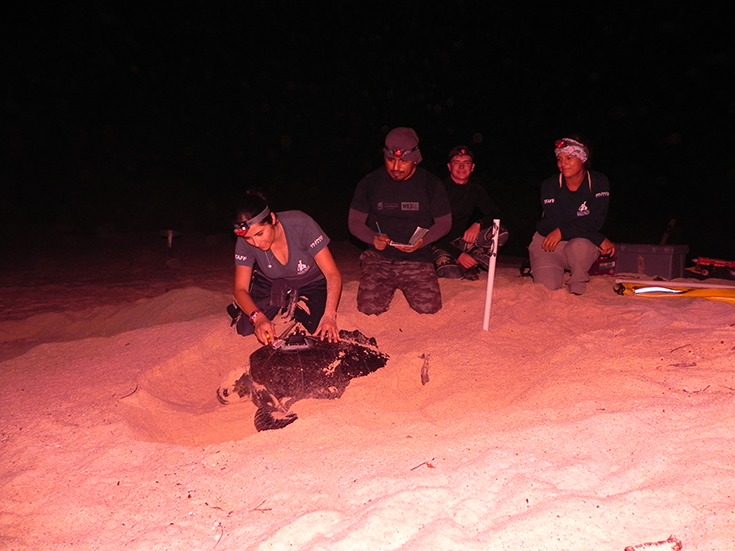
Deploying the device is a process that has to happen as quick as possible. First, we wait until the turtle has laid more than 40 eggs. When a female is laying her eggs, she enters a state of total relaxation, known as "nesting trance", in which she is less likely to be disturbed by our presence. That's when we start cleaning the carapace by removing residues of barnacles and algae. Then we attach the device using a special glue which is not harmful to the sea turtle. During this process, the turtle does not feel pain when placing the device. Minutes later, after laying the rest of her eggs, the turtle returns to the sea.
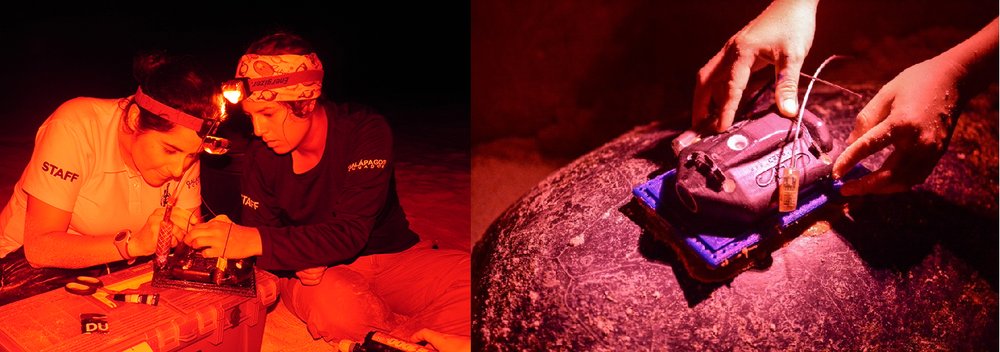
After the successful deployment, our work on the beach is momentarily concluded and we can return to the research station. The long-awaited return.
Ten days after the deployment, we return to the beach to meet our turtle and retrieve the device. We walk throughout the night to see all the turtles visiting the beach, since any of them could be our turtle equipped with the device. To avoid disturbing turtles with our presence, we do not use flashlights or any lights that can disturb them. Once we find our turtle, we remove the device from her carapace and download the collected information from the tracking days.
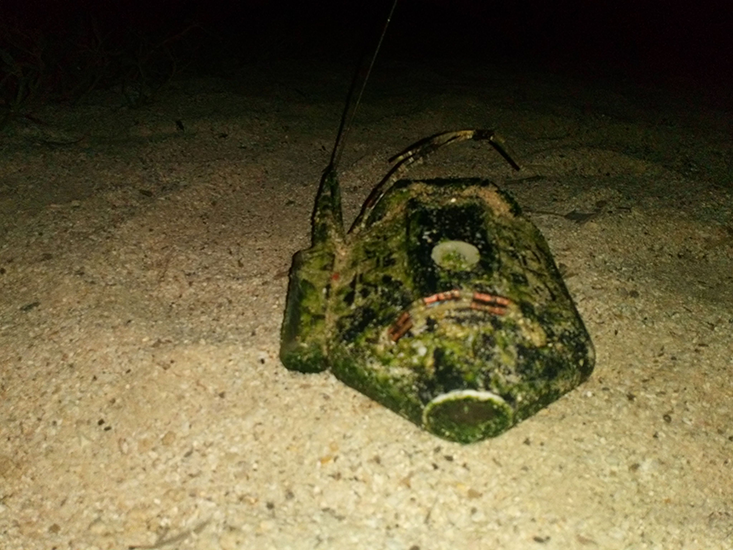
Thanks to this device we can obtain a lot of information from the monitored turtles and know the behaviors they carry out. We know where they go during the days between nesting and what dangers they face during that period.
The research season of sea turtles ends every year with the satisfaction of a great job done and the joy of knowing we gave our maximum effort. The information collected will be of great importance for conducting the analyses and finding results that will help the authorities implement new conservation measures and management plans to help conserve turtles within the GMR.
My participation in the project over the past two years has been made possible by the financial support of Mr. Eugene Chuang and Mrs. Karen Lo, IGTOA, Galapagos Conservancy Canada and the Prince Albert II of Monaco Foundation. I want to thank the CDF and Macarena Parra, leader of this project and Byron Delgado. Special thanks to all the park rangers and volunteers of the GNP and CDF who supported us in the field and the Galapagos National Park Directorate that allow the development of this project.




